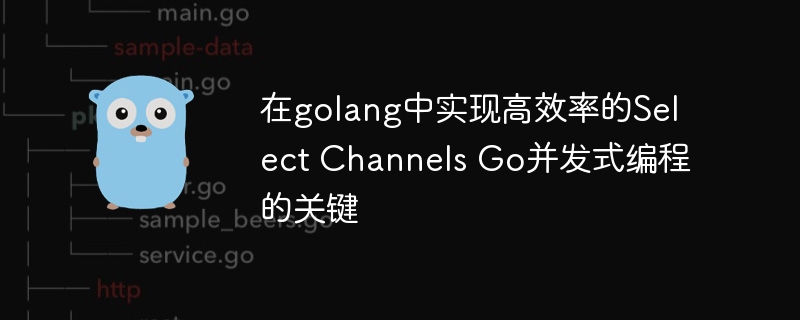Home >Backend Development >Golang >The key to achieving efficient Select Channels Go concurrent programming in golang
The key to achieving efficient Select Channels Go concurrent programming in golang
- PHPzOriginal
- 2023-09-28 08:54:41914browse

The key to achieving efficient Select Channels Go concurrent programming in golang
The Go language is a fast, efficient, and concurrent programming language that provides Powerful concurrency primitives allow developers to easily implement concurrent processing in programs. In the Go language, the channels communication mechanism is the core of its concurrent programming, and the select statement is an important manipulation tool for channels.
In this article, we will introduce in detail how to achieve efficient concurrent programming in the Go language and illustrate it through specific code examples.
- Create channels
In the Go language, we create channels through the make function. The following example code demonstrates how to create a channel that can pass strings.
ch := make(chan string)
- Send data to channel
By using the go keyword, we can send data to the channel in a new goroutine. The following sample code demonstrates how to send a piece of data to the channel created earlier.
go func() {
ch <- "Hello, world!"
}()- Receive data from channel
We can use the <-operator to receive data from the channel. The following sample code demonstrates how to receive a piece of data from the previously created channel.
data := <-ch fmt.Println(data)
- Use the select statement
The select statement can monitor multiple channels at the same time and respond to the first available channel. When multiple channels are available, the select statement will randomly select an available channel to process. The following sample code demonstrates how to use the select statement to process multiple channels.
ch1 := make(chan string)
ch2 := make(chan string)
go func() {
time.Sleep(time.Second)
ch1 <- "Hello"
}()
go func() {
time.Sleep(2 * time.Second)
ch2 <- "World"
}()
select {
case msg1 := <-ch1:
fmt.Println("Received", msg1)
case msg2 := <-ch2:
fmt.Println("Received", msg2)
}In the above code, we create two channels and send data to them in different goroutines. Using the select statement, we can wait for data in any channel and print out the corresponding message.
- Avoid blocking
In concurrent programming, we need to pay attention to avoid code that may cause deadlock or blocking. The select statement of the Go language can help us solve this problem and implement non-blocking operations through the default branch. The following example code demonstrates how to use the default branch to avoid blocking.
ch := make(chan int)
select {
case <-ch:
// 处理接收到的数据
case <-time.After(1 * time.Second):
// 超时处理
default:
fmt.Println("No data received")
}In the above code, we implement timeout processing by using the time.After function in the select statement. If no data is received from the channel within 1 second, the default branch will be executed and "No data received" will be printed.
Through the above code examples, we can see the key to achieving efficient Select Channels Go concurrent programming in the Go language. By properly using channels and select statements, we can easily implement concurrent processing and non-blocking operations, improving program efficiency and performance.
Summary:
- The channels communication mechanism of Go language is the core of concurrent programming, and channels are created through the make function.
- By using the go keyword, data can be sent to the channel in goroutine.
- Use the <- operator to receive data from the channel.
- The select statement is used to monitor multiple channels and respond to the first available channel.
- Use default branch to avoid blocking operations.
I hope this article can help readers achieve efficient concurrent programming in Go language and can be used flexibly in actual development.
The above is the detailed content of The key to achieving efficient Select Channels Go concurrent programming in golang. For more information, please follow other related articles on the PHP Chinese website!

